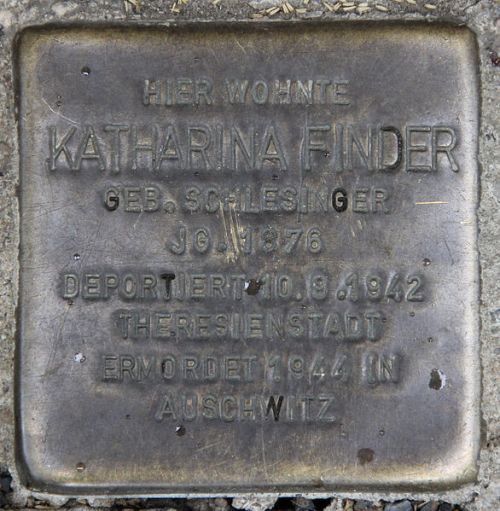Stumbling Stone Eislebener Straße 9
This small, brass memorial plaque (Stolperstein or stumbling stone) commemorates:
* Katharina Finder née Schlesinger, born 1876, deported 10 September 1942, Theresienstadt, murdered 1944 in Auschwitz.
Katharina Schlesinger and her only sibling Helene were both born in Berlin. Katharina married Dr. Georg Finder in 1895, who joined the Medical Faculty at the University of Berlin. He also practiced ear, nose, and throat medicine. Georg Finder died in 1931 at age 64. Käthe and Georg Finder’s two daughters – Eva and Hilde -- married and escaped from Germany with their families.
In 1939, Käthe’s sister and brother-in-law, Helene and Max Herrmann, moved in with her. Other family, friends, and colleagues tried to get the 3 of them out of Germany together but did not succeed.
Once the deportation order had been received, the Reich then made them declare all their assessts. On 8 September, the three were taken to a so-called Reception Center where they were told that their property had been confiscated by the Reich. Two days later, Käthe Finder, Max Herrmann, and Helene Herrmann were deported on the 61st Eldertransport to Theresienstadt. Max was dead there 2 months later. On 16 May 1944, Käthe Finder and Helene Herrmann were deported from Theresienstadt to the extermination camp at Auschwitz. If they survived the journey, they were processed, put into a so-called Family Camp for a while. Anyone still in the Family Camp on 10 July 1944 was taken to the gas chambers and murdered.
There are stolpersteine for Katharina’s sister Helene Herrmann and her husband Max at Augsburger Strasse 42 in BerlinCharlottenburg.
"Stolpersteine" is an art project for Europe by Gunter Demnig to commemorate victims of National Socialism (Nazism). Stolpersteine (stumbling stones) are small, 10x10cm brass plaques placed in the pavement in front of the last voluntary residence of (mostly Jewish) victims who were murdered by the Nazis. Each plaque is engraved with the victim’s name, date of birth, and place (mostly a concentration camp) and date of death. By doing this, Gunter Demnig gives an individual memorial to each victim. One stone, one name, one person. He cites the Talmud: "A human being is forgotten only when his or her name is forgotten."
Do you have more information about this location? Inform us!
Source
- Text: Fedor de Vries & Anne Palmer
- Photos: OTFW
- Stolpersteine in Berlin: Katharina Finder
- Yad Vashem Transport Ea, Theresienstadt-Auschwitz, 16 May 1944
- Stolpersteine.eu
Nearby
Museum
Point of interest
- Location NSB District Office North and East Germany - Berlin
- Kaiser-Wilhelm-Gedächtniskirche Berlin - Berlin
- Kaufhaus des Westens (KaDeWe) - Berlin
Monument
- Memorial Killed Czech Forced Laborers - Berlin-Charlottenburg
- Memorial Palästina-Amt - Berlin-Charlottenburg
- Memorial Joachimsthalsches Gymnasium - Berlin-Wilmersdorf
Cemetery
- Grave Arthur Axmann - Berlin-Wilmersdorf
- German War Graves Friedhof Wilmersdorf - Berlin-Wilmersdorf
- Temporary Graves Executed Members Plot Against Hitler 20 July 1944 - Berlin-Schöneberg
Remembrance Stone
- Stumbling Stones Rankestraße 9 - Berlin-Charlottenburg
- Stumbling Stones Augsburger Straße 33 - Berlin-Charlottenburg
- Stumbling Stone Eislebener Straße 4 - Berlin-Charlottenburg




